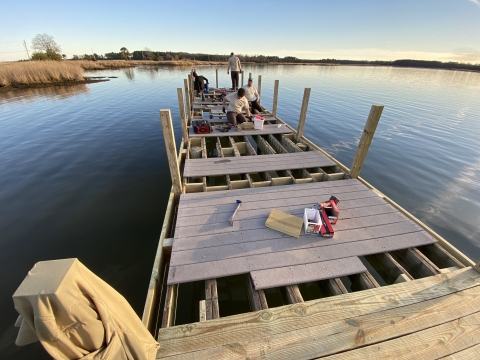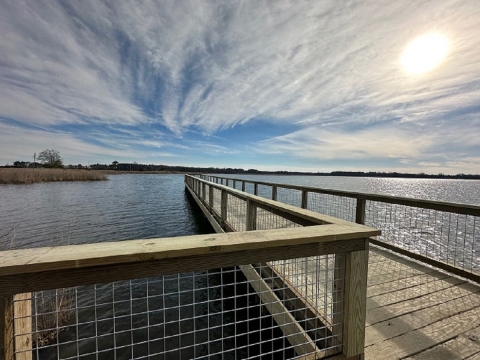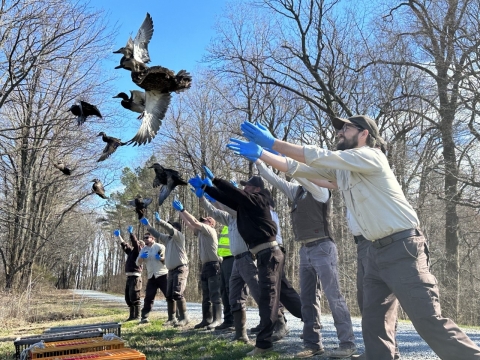Kris had been coming to Occoquan Bay National Wildlife Refuge in Virginia for more than two years. She loved snapping photos from her car along the Wildlife Drive, but since she relies on a manual wheelchair, the refuge’s unpaved trails had remained mostly inaccessible to her.
That is, until one summer afternoon, when she arrived at the refuge to a wonderful surprise: a recently opened visitor center trail, built by a U.S. Fish and Wildlife Service maintenance team. Kris had such a nice day at the refuge she wrote to the refuge manager, Amanda Daisey:
“What a beautiful facility. I loved sitting on the covered porch after I explored the loop trail that goes around Painted Turtle Pond, and I decided to write to tell you how happy I am with the recent upgrades to this refuge. The visitor's center and the accessibility of the trail (it is pretty smooth and there aren't a lot of rocks), including the observation deck at the pond, are real enhancements, and I am grateful that I now have more terrain to explore when I come to visit.
During her visit, Kris sat at the new observation deck at Painted Turtle Pond and captured photos of a bald eagle, an egret and a green heron – all within a couple minutes.
Kris’s story is an example of the powerful experiences well-maintained infrastructure provides for visitors and employees alike: Service lands that are safer and more accessible for everyone.
Thanks to additional funding from the Great American Outdoors Act Great American Outdoors Act
This landmark conservation law, enacted in 2020, authorizes the use of up to $1.9 billion a year in energy development revenues for five years for needed maintenance to facilities and infrastructure in our wildlife refuges, national parks, forests, recreation areas and American Indian schools.
Learn more about Great American Outdoors Act , our dedicated maintenance professionals are coming together to tackle some big jobs that have needed attention for a long time. And their work is getting great reviews.
Tackling the backlog
Infrastructure is always degrading. Not unlike the mythical multi-headed hydra, as one problem is fixed, others develop. Structures and facilities at national wildlife refuges and other Service facilities are particularly vulnerable to deterioration due to their locations, as well as the increasingly destructive effects of climate change climate change
Climate change includes both global warming driven by human-induced emissions of greenhouse gases and the resulting large-scale shifts in weather patterns. Though there have been previous periods of climatic change, since the mid-20th century humans have had an unprecedented impact on Earth's climate system and caused change on a global scale.
Learn more about climate change . Although facility maintenance staff do their best to keep up, limited resources often cause projects to be delayed, or deferred, leading to a growing backlog of work to be done.
To tackle this list of postponed projects, we assemble Maintenance Action Teams: groups of Service maintenance professionals that come together to do short-term construction, habitat restoration, and demolition projects that would otherwise go to a private contractor.
Maintenance Action Teams have numerous benefits: They develop skillsets for employees through on-the-job training; they create and strengthen employee relationships; and they make us more resilient and adaptable as an agency. They offer some nice cost-savings, too.
The Great American Outdoors Act, passed in 2020, gives the Service funding – nearly $100 million annually – to reduce the list of deferred maintenance projects. That includes repairing or replacing visitor facilities – like the one at Occoquan Bay – as well as roads, trails and other critical infrastructure. By leveraging Great American Outdoors Act funding with that from other sources, we can make maintenance miracles happen in the places they’re needed most.
Maintenance supergroup
This winter, Eastern Neck National Wildlife Refuge in Maryland welcomed 19 talented Service maintenance professionals hailing from all over the U.S. – from Alaska to Oklahoma to New York and Louisiana. This was the first national Great American Outdoors Act Strike Force. Think supergroup, like the Traveling Wilburys … if the Traveling Wilburys had impact drills and chainsaws rather than guitars.
So, what brings a crew of this scope together to an island refuge in the Chesapeake Bay? Well, a boardwalk.
The Tubby Cove Boardwalk stretches approximately 500 feet across the refuge’s healthy marshlands and is a fantastic spot for birding, watching wildlife or taking the dog for a walk (on a leash, of course). Visitors and locals from the nearby town of Rock Hall have been enjoying it for decades. Sadly, its deterioration over time, in part due to severe flooding, had rendered it defunct.
It wasn’t the only one either; the Tundra Swan Boardwalk, another popular access point on the refuge, closed to the public in 2021 due to failing conditions.
The maintenance couldn’t happen soon enough, said Refuge Manager Marcia Pradines Long. Over the years, the Friends of Eastern Neck raised funds for “patch-ups” to the boardwalks, but it became obvious that eventually a major overhaul would be needed. That’s where the Strike Forces came in.
Here’s how these projects went down:
First, a local maintenance team began work on both boardwalks, a process that carried on for nearly a year. Progress was made, but it became evident to refuge staff that they were going to need significantly more resources (and people) than they anticipated. So, they called in help.
In came the Regional Strike Force, a larger team comprised of staff from Service facilities throughout the Northeast. They focused their efforts on finishing Tundra Swan, replacing the beams, joists, decking and handrails for the roughly 150-foot boardwalk. For the first time in two years, Tundra Swan was open for business – and looking better than ever.
That left Tubby Cove (a bigger project) and the National Strike Force (the biggest team). In just one day, the group demolished all 500 feet of the old boardwalk – but that was only the beginning. The next two weeks brought 12–13-hour days, bitter cold, blustery weather ... and the occasional misstep into freezing-cold waters. Suffice it to say, winter isn’t the easiest season for construction. More reason to get the work done quickly.
Pradines was amazed by how well this team of strangers came together despite the challenges. “So often in those kinds of conditions, you can really get sick of each other,” she said, laughing. “But they worked so well together. It was extremely rewarding to see.”
As a token of gratitude for braving the Maryland winter, refuge staff treated the team to some lunchtime duck banding. It was a great opportunity to show the team how their work directly connects to and supports conservation, Pradines explained.
“We wanted to bring them in and give them a sense of why we’re here and what we do here at the refuge,” she said.
Hard work paid off
The difference is like night and day. Both boardwalks are back open and wheelchair-accessible. In addition, refuge roads and visitor parking were repaired and improved, and new interpretive kiosks were installed. Pradines is already getting positive feedback on the makeover.
"Smaller refuges like ours might sometimes feel that we have been overlooked,” said Simon Kenyon, president of the Friends of Eastern Neck. “The amazing work of the Strike Teams showed that that is not the case. Our boardwalks and viewing areas are in great shape again, ready to welcome new seasons of bird migration and the visitors that love them."
Pradines is just as thrilled and excited to welcome visitors to the recreation sites once again. She noted that Eastern Neck National Wildlife Refuge has been Rock Hall’s pride and joy for many years.
“Bringing in the Great American Outdoors Act Strike Force from around the country was that extra push that we needed to get it done. If it wouldn’t have been for them, it still wouldn’t be done.”
And to top it off, hiring a third-party would’ve cost the government $300,000 more than using the Strike Force for these projects.
Our maintenance professionals are unsung heroes. Behind the scenes, they’re doing work that supports nearly every conservation and recreation activity that occurs on Service lands.
The next time you stop in at a refuge visitor center, enjoy a paved nature trail, or watch wildlife on the pond from the pier, you might take a minute to appreciate the incredible levels of creativity and collaboration that has gone into them. Those efforts ensure everyone is welcome and able to enjoy the beauty our country has to offer.













